Analyzing Dove's Advertisement and Its Promotion of Racial Inequality
VerifiedAdded on 2023/01/17
|5
|1073
|73
Essay
AI Summary
This essay examines a Dove advertisement to analyze how it promotes racial inequality. It begins by highlighting the power of media to influence audiences and the importance of representing content accurately. The essay focuses on a Dove Facebook ad depicting a black woman transitioning into a white woman after using the product, arguing that the ad perpetuates a racist trope by suggesting dark skin is undesirable. It discusses the concept of structured inequality and how institutions like media can reinforce it. The essay then applies the theory of symbolic interactionism to explain how the ad communicates prejudiced behavior and reinforces racial identities. Finally, it raises questions about how to avoid such prejudice in media content and suggests avenues for future research, including content filtering and investigation of discriminatory intent. The essay concludes by emphasizing the need for media to promote positive changes and avoid reinforcing racial biases.
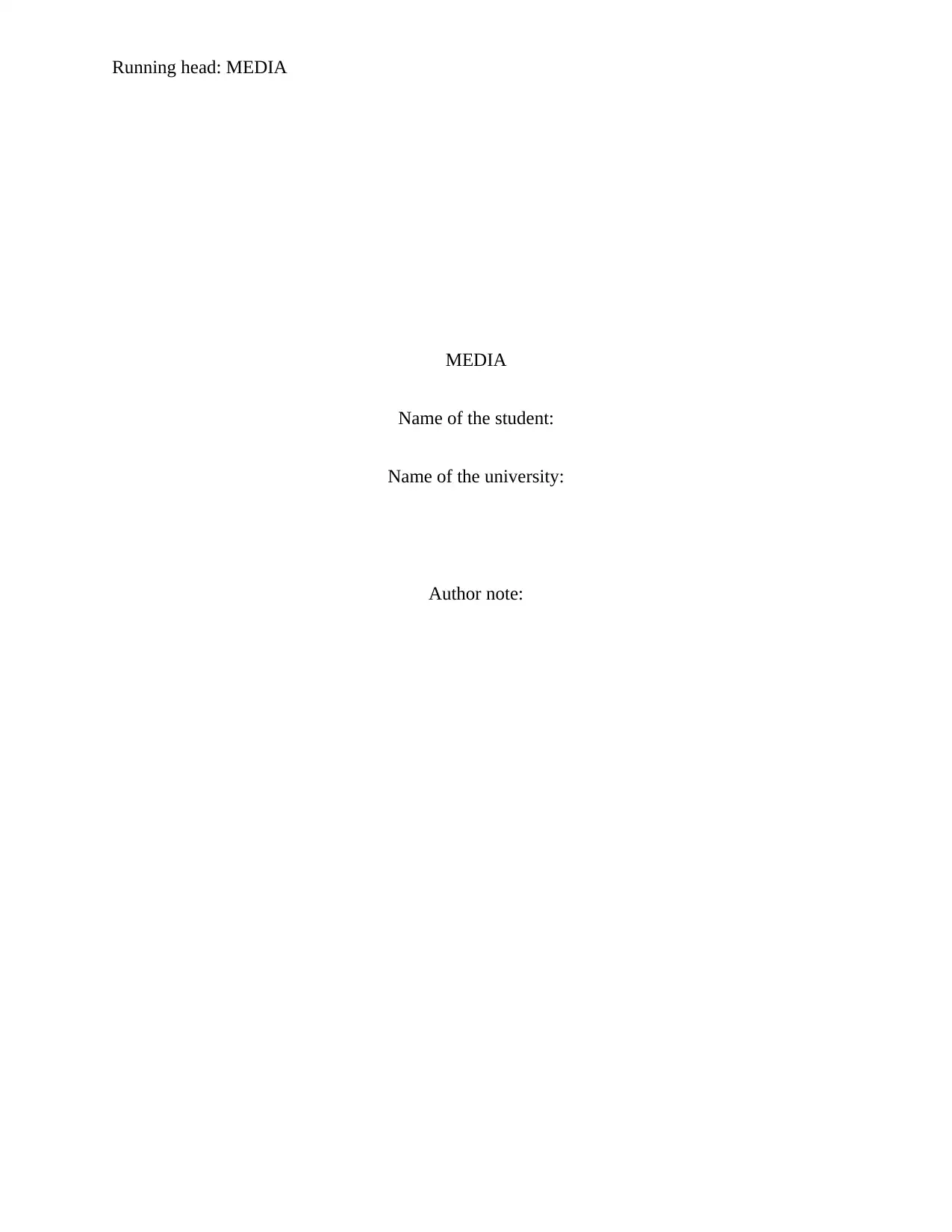
Running head: MEDIA
MEDIA
Name of the student:
Name of the university:
Author note:
MEDIA
Name of the student:
Name of the university:
Author note:
Paraphrase This Document
Need a fresh take? Get an instant paraphrase of this document with our AI Paraphraser
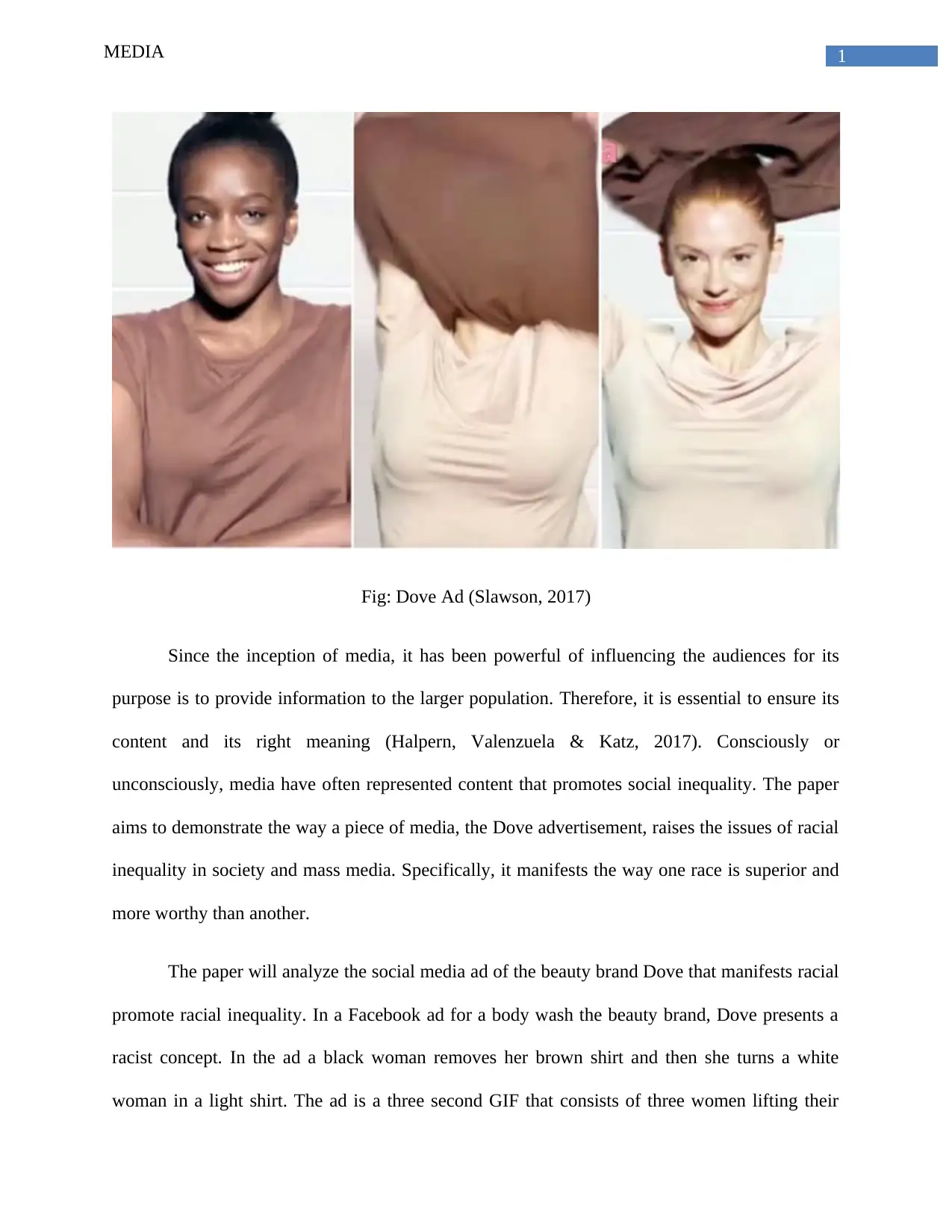
1MEDIA
Fig: Dove Ad (Slawson, 2017)
Since the inception of media, it has been powerful of influencing the audiences for its
purpose is to provide information to the larger population. Therefore, it is essential to ensure its
content and its right meaning (Halpern, Valenzuela & Katz, 2017). Consciously or
unconsciously, media have often represented content that promotes social inequality. The paper
aims to demonstrate the way a piece of media, the Dove advertisement, raises the issues of racial
inequality in society and mass media. Specifically, it manifests the way one race is superior and
more worthy than another.
The paper will analyze the social media ad of the beauty brand Dove that manifests racial
promote racial inequality. In a Facebook ad for a body wash the beauty brand, Dove presents a
racist concept. In the ad a black woman removes her brown shirt and then she turns a white
woman in a light shirt. The ad is a three second GIF that consists of three women lifting their
Fig: Dove Ad (Slawson, 2017)
Since the inception of media, it has been powerful of influencing the audiences for its
purpose is to provide information to the larger population. Therefore, it is essential to ensure its
content and its right meaning (Halpern, Valenzuela & Katz, 2017). Consciously or
unconsciously, media have often represented content that promotes social inequality. The paper
aims to demonstrate the way a piece of media, the Dove advertisement, raises the issues of racial
inequality in society and mass media. Specifically, it manifests the way one race is superior and
more worthy than another.
The paper will analyze the social media ad of the beauty brand Dove that manifests racial
promote racial inequality. In a Facebook ad for a body wash the beauty brand, Dove presents a
racist concept. In the ad a black woman removes her brown shirt and then she turns a white
woman in a light shirt. The ad is a three second GIF that consists of three women lifting their
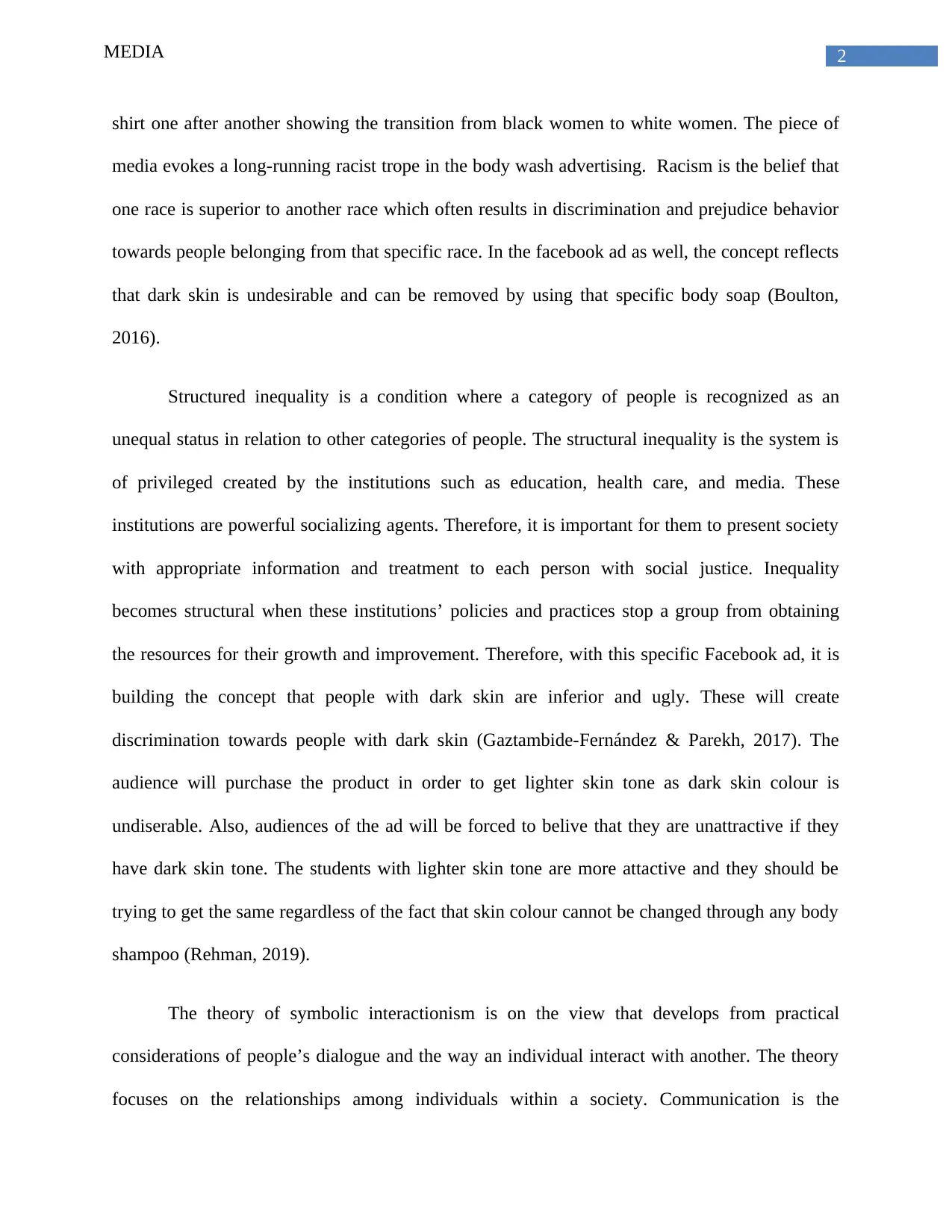
2MEDIA
shirt one after another showing the transition from black women to white women. The piece of
media evokes a long-running racist trope in the body wash advertising. Racism is the belief that
one race is superior to another race which often results in discrimination and prejudice behavior
towards people belonging from that specific race. In the facebook ad as well, the concept reflects
that dark skin is undesirable and can be removed by using that specific body soap (Boulton,
2016).
Structured inequality is a condition where a category of people is recognized as an
unequal status in relation to other categories of people. The structural inequality is the system is
of privileged created by the institutions such as education, health care, and media. These
institutions are powerful socializing agents. Therefore, it is important for them to present society
with appropriate information and treatment to each person with social justice. Inequality
becomes structural when these institutions’ policies and practices stop a group from obtaining
the resources for their growth and improvement. Therefore, with this specific Facebook ad, it is
building the concept that people with dark skin are inferior and ugly. These will create
discrimination towards people with dark skin (Gaztambide-Fernández & Parekh, 2017). The
audience will purchase the product in order to get lighter skin tone as dark skin colour is
undiserable. Also, audiences of the ad will be forced to belive that they are unattractive if they
have dark skin tone. The students with lighter skin tone are more attactive and they should be
trying to get the same regardless of the fact that skin colour cannot be changed through any body
shampoo (Rehman, 2019).
The theory of symbolic interactionism is on the view that develops from practical
considerations of people’s dialogue and the way an individual interact with another. The theory
focuses on the relationships among individuals within a society. Communication is the
shirt one after another showing the transition from black women to white women. The piece of
media evokes a long-running racist trope in the body wash advertising. Racism is the belief that
one race is superior to another race which often results in discrimination and prejudice behavior
towards people belonging from that specific race. In the facebook ad as well, the concept reflects
that dark skin is undesirable and can be removed by using that specific body soap (Boulton,
2016).
Structured inequality is a condition where a category of people is recognized as an
unequal status in relation to other categories of people. The structural inequality is the system is
of privileged created by the institutions such as education, health care, and media. These
institutions are powerful socializing agents. Therefore, it is important for them to present society
with appropriate information and treatment to each person with social justice. Inequality
becomes structural when these institutions’ policies and practices stop a group from obtaining
the resources for their growth and improvement. Therefore, with this specific Facebook ad, it is
building the concept that people with dark skin are inferior and ugly. These will create
discrimination towards people with dark skin (Gaztambide-Fernández & Parekh, 2017). The
audience will purchase the product in order to get lighter skin tone as dark skin colour is
undiserable. Also, audiences of the ad will be forced to belive that they are unattractive if they
have dark skin tone. The students with lighter skin tone are more attactive and they should be
trying to get the same regardless of the fact that skin colour cannot be changed through any body
shampoo (Rehman, 2019).
The theory of symbolic interactionism is on the view that develops from practical
considerations of people’s dialogue and the way an individual interact with another. The theory
focuses on the relationships among individuals within a society. Communication is the
⊘ This is a preview!⊘
Do you want full access?
Subscribe today to unlock all pages.

Trusted by 1+ million students worldwide
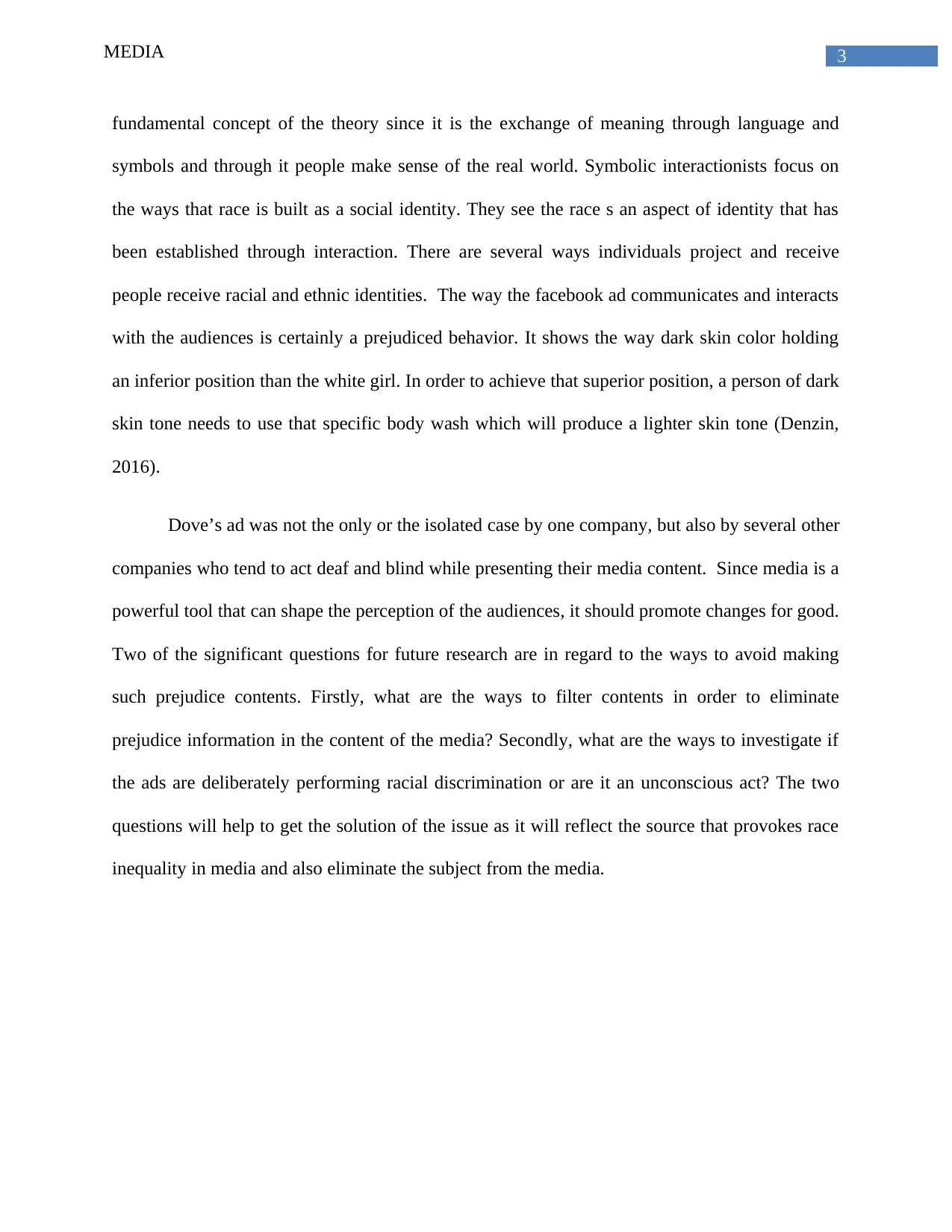
3MEDIA
fundamental concept of the theory since it is the exchange of meaning through language and
symbols and through it people make sense of the real world. Symbolic interactionists focus on
the ways that race is built as a social identity. They see the race s an aspect of identity that has
been established through interaction. There are several ways individuals project and receive
people receive racial and ethnic identities. The way the facebook ad communicates and interacts
with the audiences is certainly a prejudiced behavior. It shows the way dark skin color holding
an inferior position than the white girl. In order to achieve that superior position, a person of dark
skin tone needs to use that specific body wash which will produce a lighter skin tone (Denzin,
2016).
Dove’s ad was not the only or the isolated case by one company, but also by several other
companies who tend to act deaf and blind while presenting their media content. Since media is a
powerful tool that can shape the perception of the audiences, it should promote changes for good.
Two of the significant questions for future research are in regard to the ways to avoid making
such prejudice contents. Firstly, what are the ways to filter contents in order to eliminate
prejudice information in the content of the media? Secondly, what are the ways to investigate if
the ads are deliberately performing racial discrimination or are it an unconscious act? The two
questions will help to get the solution of the issue as it will reflect the source that provokes race
inequality in media and also eliminate the subject from the media.
fundamental concept of the theory since it is the exchange of meaning through language and
symbols and through it people make sense of the real world. Symbolic interactionists focus on
the ways that race is built as a social identity. They see the race s an aspect of identity that has
been established through interaction. There are several ways individuals project and receive
people receive racial and ethnic identities. The way the facebook ad communicates and interacts
with the audiences is certainly a prejudiced behavior. It shows the way dark skin color holding
an inferior position than the white girl. In order to achieve that superior position, a person of dark
skin tone needs to use that specific body wash which will produce a lighter skin tone (Denzin,
2016).
Dove’s ad was not the only or the isolated case by one company, but also by several other
companies who tend to act deaf and blind while presenting their media content. Since media is a
powerful tool that can shape the perception of the audiences, it should promote changes for good.
Two of the significant questions for future research are in regard to the ways to avoid making
such prejudice contents. Firstly, what are the ways to filter contents in order to eliminate
prejudice information in the content of the media? Secondly, what are the ways to investigate if
the ads are deliberately performing racial discrimination or are it an unconscious act? The two
questions will help to get the solution of the issue as it will reflect the source that provokes race
inequality in media and also eliminate the subject from the media.
Paraphrase This Document
Need a fresh take? Get an instant paraphrase of this document with our AI Paraphraser
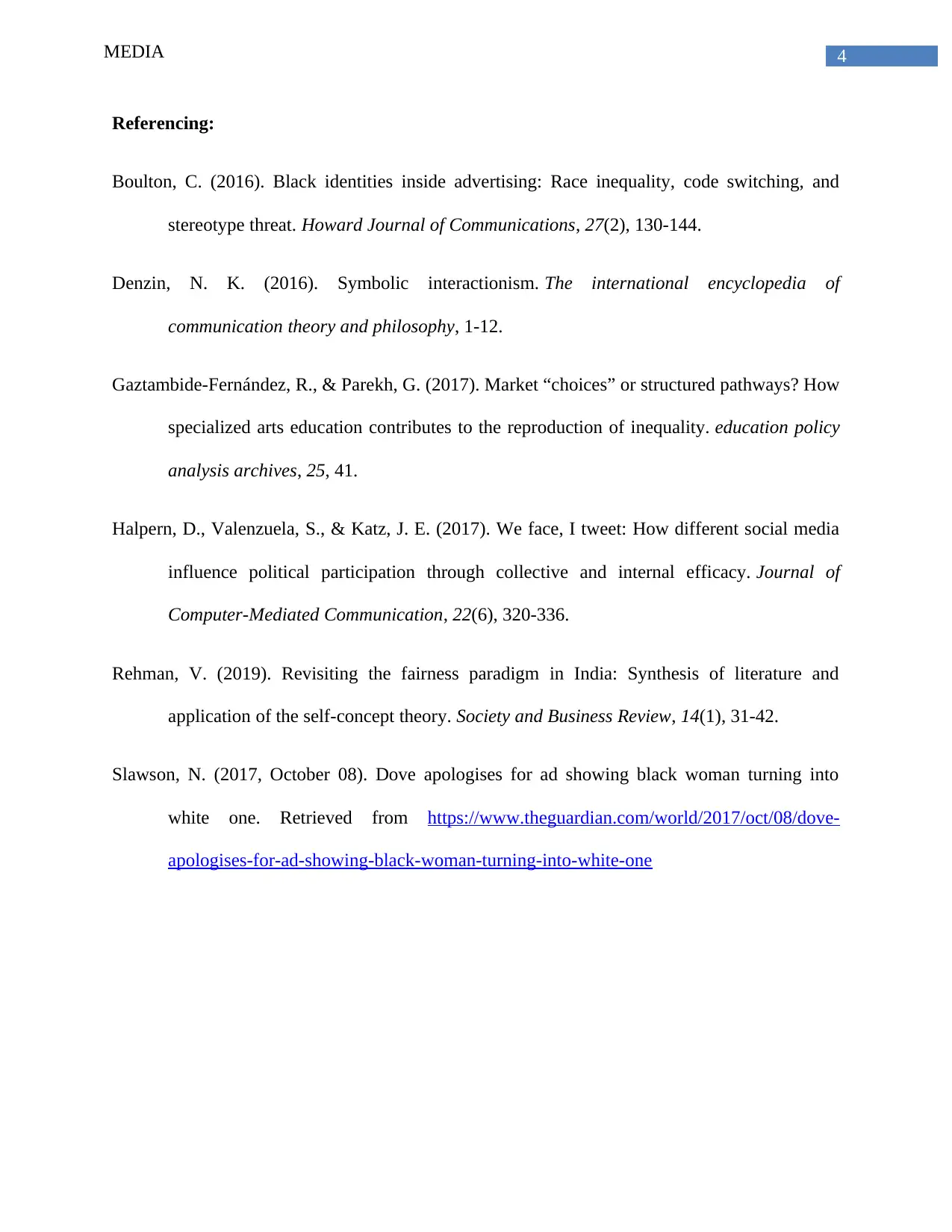
4MEDIA
Referencing:
Boulton, C. (2016). Black identities inside advertising: Race inequality, code switching, and
stereotype threat. Howard Journal of Communications, 27(2), 130-144.
Denzin, N. K. (2016). Symbolic interactionism. The international encyclopedia of
communication theory and philosophy, 1-12.
Gaztambide-Fernández, R., & Parekh, G. (2017). Market “choices” or structured pathways? How
specialized arts education contributes to the reproduction of inequality. education policy
analysis archives, 25, 41.
Halpern, D., Valenzuela, S., & Katz, J. E. (2017). We face, I tweet: How different social media
influence political participation through collective and internal efficacy. Journal of
Computer-Mediated Communication, 22(6), 320-336.
Rehman, V. (2019). Revisiting the fairness paradigm in India: Synthesis of literature and
application of the self-concept theory. Society and Business Review, 14(1), 31-42.
Slawson, N. (2017, October 08). Dove apologises for ad showing black woman turning into
white one. Retrieved from https://www.theguardian.com/world/2017/oct/08/dove-
apologises-for-ad-showing-black-woman-turning-into-white-one
Referencing:
Boulton, C. (2016). Black identities inside advertising: Race inequality, code switching, and
stereotype threat. Howard Journal of Communications, 27(2), 130-144.
Denzin, N. K. (2016). Symbolic interactionism. The international encyclopedia of
communication theory and philosophy, 1-12.
Gaztambide-Fernández, R., & Parekh, G. (2017). Market “choices” or structured pathways? How
specialized arts education contributes to the reproduction of inequality. education policy
analysis archives, 25, 41.
Halpern, D., Valenzuela, S., & Katz, J. E. (2017). We face, I tweet: How different social media
influence political participation through collective and internal efficacy. Journal of
Computer-Mediated Communication, 22(6), 320-336.
Rehman, V. (2019). Revisiting the fairness paradigm in India: Synthesis of literature and
application of the self-concept theory. Society and Business Review, 14(1), 31-42.
Slawson, N. (2017, October 08). Dove apologises for ad showing black woman turning into
white one. Retrieved from https://www.theguardian.com/world/2017/oct/08/dove-
apologises-for-ad-showing-black-woman-turning-into-white-one
1 out of 5
Your All-in-One AI-Powered Toolkit for Academic Success.
+13062052269
info@desklib.com
Available 24*7 on WhatsApp / Email
![[object Object]](/_next/static/media/star-bottom.7253800d.svg)
Unlock your academic potential
Copyright © 2020–2025 A2Z Services. All Rights Reserved. Developed and managed by ZUCOL.

